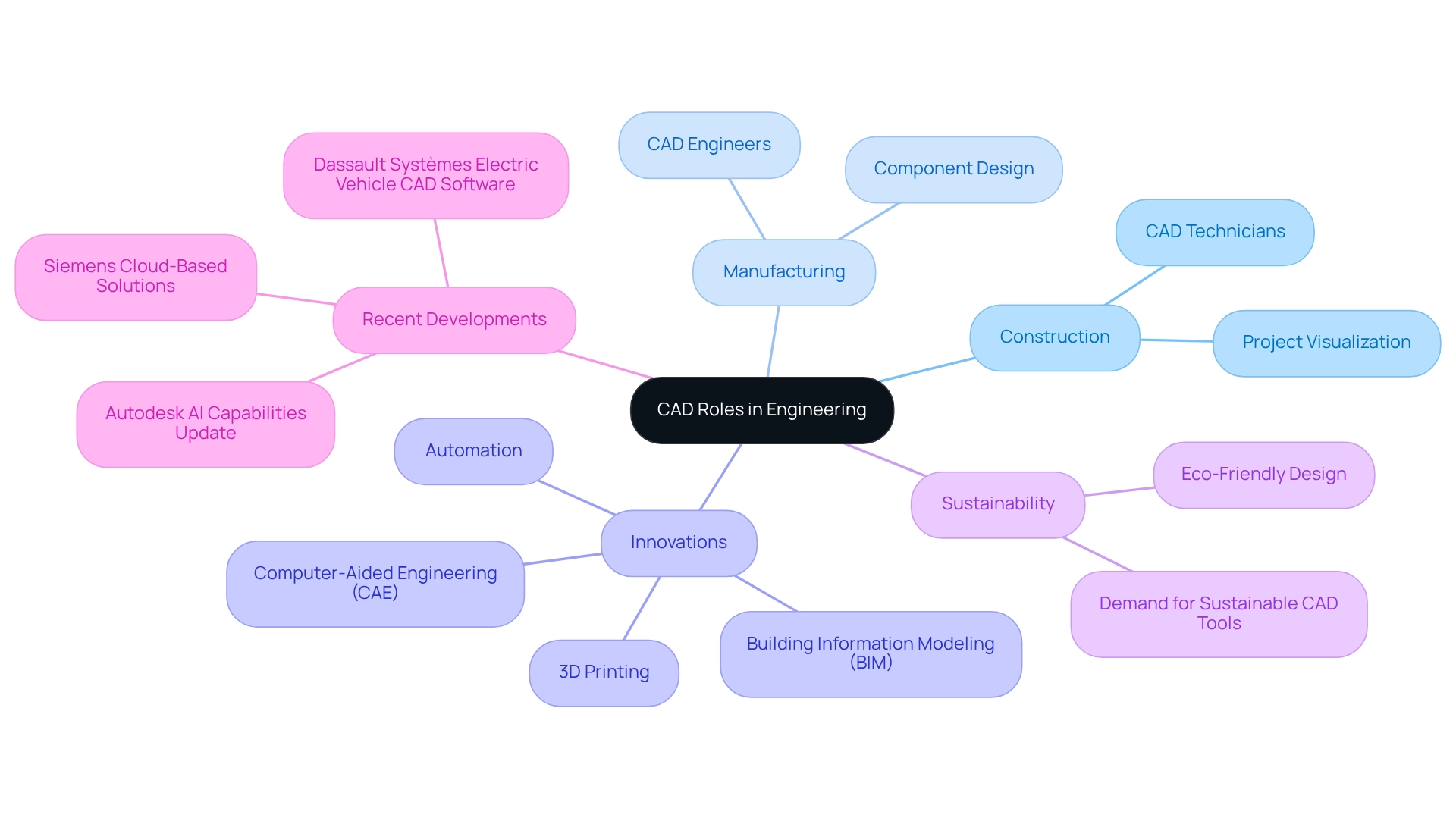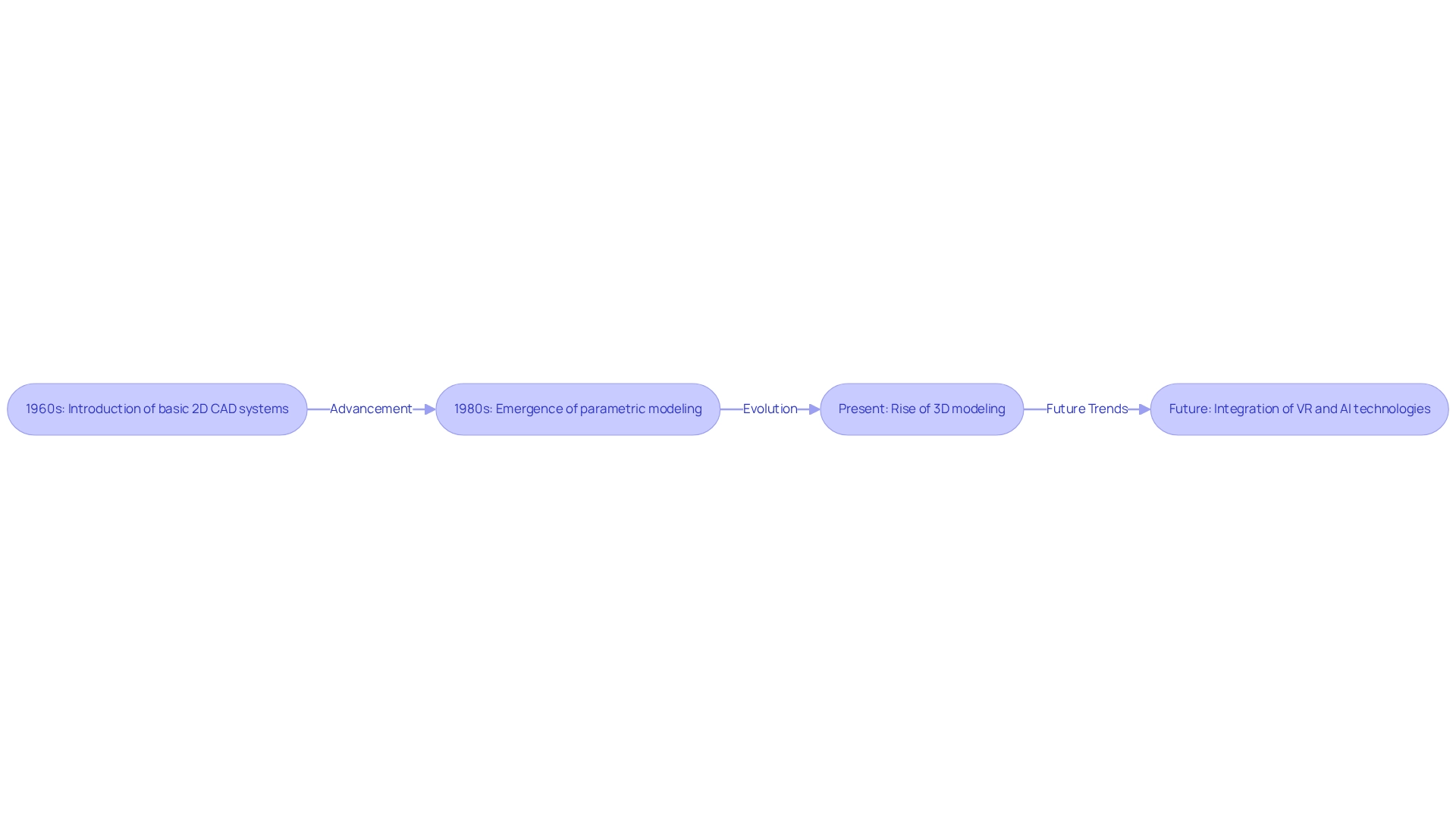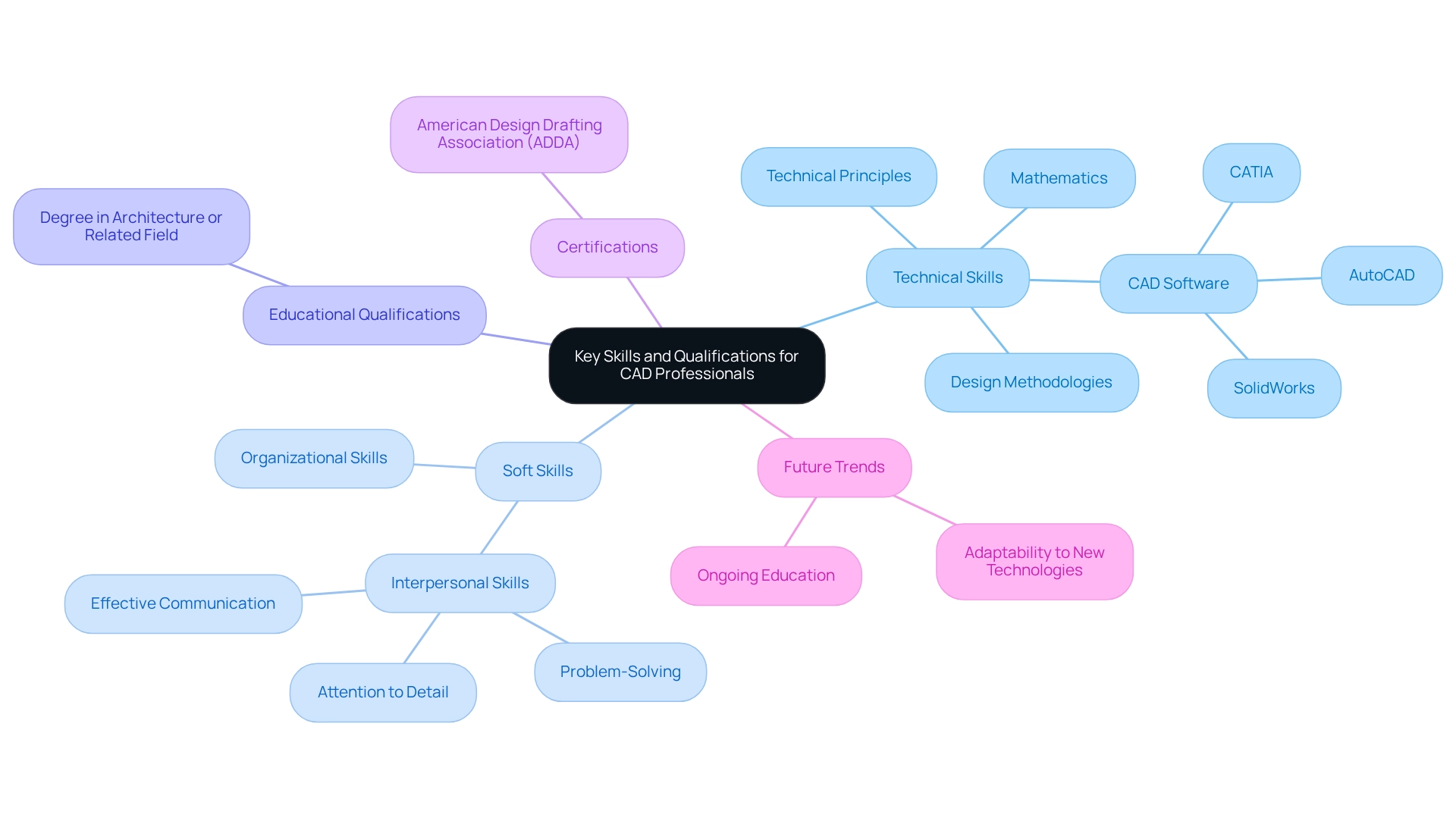Overview
The article underscores the critical roles, skills, and evolution of engineering CAD jobs, establishing their significance across diverse sectors and projecting a substantial growth in demand for these positions by 2025. It highlights the transition from fundamental 2D drafting to sophisticated 3D modeling and parametric design. This evolution necessitates that CAD professionals not only possess robust technical skills but also exhibit adaptability to emerging technologies such as AI and VR, ensuring their success in a rapidly evolving industry.
Key Highlights:
- Engineering CAD jobs include roles such as CAD engineers, drafters, and technicians, essential for creating accurate technical drawings and models.
- These roles are critical in sectors like mechanical, civil, electrical, and architectural engineering.
- By 2025, significant growth in CAD job opportunities is expected in the U.S. and Canada, driven by demand for skilled professionals.
- CAD specialists enhance project efficiency and collaboration among stakeholders in technical projects.
- Recent trends show increased reliance on CAD technology due to advancements in design practices and the need for accuracy.
- The integration of CAD with tools like Building Information Modeling (BIM) and Computer-Aided Engineering (CAE) is improving project outcomes.
- The evolution of CAD jobs has progressed from basic 2D drafting in the 1960s to advanced 3D modeling and parametric design.
- Industry 4.0 is expected to further drive growth in CAD roles, necessitating knowledge of integrated technologies like AI and VR.
- Key skills for CAD professionals include proficiency in CAD software, technical principles, and strong interpersonal skills.
- Ongoing education and certifications are crucial for CAD professionals to stay relevant in a rapidly evolving industry.
Introduction
In the realm of engineering, the demand for precision and innovation has never been higher. At the forefront of this evolution are Computer-Aided Design (CAD) professionals. These skilled individuals transform abstract concepts into detailed visual representations, playing a critical role across various engineering disciplines, from construction to manufacturing. As industries embrace advanced technologies and methodologies, the landscape of CAD jobs is rapidly changing. This evolution requires professionals to adapt and evolve.
This article delves into the multifaceted world of engineering CAD roles, exploring their significance, evolution, key skills required, and the growing opportunities that lie ahead as the industry continues to innovate. Are you ready to understand the pivotal role CAD professionals play in shaping the future of engineering?
Define Engineering CAD Jobs
CAD roles in the field encompass a variety of positions that leverage Computer-Aided Design (CAD) software to produce detailed drawings and models essential for technical projects. Notable roles include:
- CAD engineers
- CAD drafters
- CAD technicians
Each tasked with converting technical concepts into precise visual representations. The primary objective of these specialists is to ensure that designs are both accurate and efficient, adhering to the specifications required for production or construction. These roles hold significant importance across multiple sectors, including mechanical, civil, electrical, and architectural domains, where precision and clarity in design are paramount. By 2025, the U.S. and Canada are projected to employ a substantial number of engineering CAD jobs, including CAD engineers, drafters, and technicians, highlighting the increasing demand for skilled professionals in this arena. Recent trends indicate a rising reliance on CAD technology, driven by advancements in technical practices and the necessity for enhanced design accuracy.
The importance of CAD specialists in modern design cannot be overstated; they are integral to ensuring that projects progress smoothly and efficiently. Their expertise not only enhances the technical dimensions of design but also fosters collaboration among various stakeholders in development projects. The successful placement of CAD technicians in technical firms underscores the effectiveness of targeted recruitment strategies, showcasing the value of personalized service in connecting high-quality candidates with employers in this competitive job market.
Boutique Recruiting provides comprehensive salary guides that offer valuable insights for both candidates and employers, ensuring they are well-informed about the financial aspects of these roles. Furthermore, our job board features a wide array of open positions across the U.S. and Canada, facilitating candidates in discovering opportunities that align with their skills and aspirations. Notably, the median pay for surveyors, a related field, stands at $68,540 in 2023, emphasizing the financial viability of careers in CAD. Additionally, the anticipated surge in engineering CAD jobs in the U.S. and Canada by 2025 further underscores the necessity for these roles. Boutique Recruiting’s impressive track record in placing CAD technicians exemplifies the efficacy of their tailored recruitment approach, ensuring that employers secure the right talent to fulfill their specific needs.

Contextualize CAD Roles in Engineering
Engineering CAD jobs are pivotal across various technical sectors, particularly in construction and manufacturing. In construction, CAD technicians craft intricate blueprints that serve as essential guides for builders and contractors, ensuring projects are executed with precision. Similarly, in manufacturing, CAD engineers are tasked with designing components and assemblies that are vital to production processes. The rise of advanced innovations, such as 3D printing and automation, has significantly escalated the demand for skilled CAD experts capable of adapting to cutting-edge tools and methodologies.
As industries continue to evolve, the integration of CAD with tools such as Building Information Modeling (BIM) and Computer-Aided Engineering (CAE) is enhancing collaboration and efficiency in engineering projects. For instance, the adoption of CAD tools in construction has revolutionized project visualization, allowing for greater accuracy and minimizing errors, ultimately conserving time and resources. This transformation is underscored in the case study titled ‘The Advantages of CAD in Construction,’ which illustrates how CAD has improved project outcomes.
Moreover, the emphasis on sustainability and eco-friendly design is gaining prominence. As Shankar Godavarti observes, “The increasing awareness of environmental concerns is driving demand for CAD tools that facilitate sustainable design practices.” This shift underscores the evolving requirements for CAD professionals who can adeptly navigate these advancements.
Recent innovations in CAD systems, such as Autodesk’s AI capabilities update and Siemens’ new cloud-based solutions, further exemplify the dynamic nature of the field. Statistics reveal a robust demand for engineering CAD jobs among CAD specialists in product design, propelled by the necessity for precision and innovation in engineering solutions. As we advance through 2025, the impact of advanced technologies on CAD roles will continue to shape the landscape, necessitating individuals to not only possess traditional CAD skills but also embrace new methodologies like 3D printing. This evolution is reflected in the experiences of CAD experts who are successfully adapting to these changes, ensuring they remain at the forefront of the industry. The ongoing innovation and adaptation within the CAD market accentuate the imperative for professionals to stay informed about industry trends.

Trace the Evolution of CAD Jobs
The evolution of CAD jobs traces its roots back to the 1960s, when the first CAD systems emerged, primarily focused on basic 2D drafting. As technology advanced, CAD software underwent significant transformations, incorporating 3D modeling features that empowered engineers to develop intricate designs. A landmark moment in this evolution unfolded in the 1980s with the introduction of parametric modeling, which enabled designers to make modifications in models that automatically updated related components, thereby enhancing efficiency and accuracy in the design process.
Industry research indicates that the rise of Industry 4.0 is set to propel substantial growth in the CAD and PLM software market, particularly across Europe. This trend suggests that CAD roles will increasingly require not only software proficiency but also a deep understanding of integrated technologies such as virtual reality (VR) and artificial intelligence (AI). These advancements are revolutionizing the design and engineering landscape, implying a future where CAD experts must swiftly adapt to evolving tools and methodologies.
As highlighted by IBISWorld, “each report is reviewed by one of IBISWorld’s editors, who provide quality assurance to ensure accuracy and readability,” underscoring the necessity for CAD professionals to remain current with industry standards. The surge in 3D modeling within engineering CAD jobs has markedly increased over the years, reflecting broader trends in innovation and industry demands. Moreover, courses like the SketchUp course, which offers bundled packages of introductory and intermediate training, emphasize the critical importance of continuous learning in this field. As the CAD industry continues to evolve, the integration of emerging technologies will be pivotal in shaping the future of engineering CAD jobs.

Identify Key Skills and Qualifications for CAD Professionals
To excel in engineering CAD jobs, individuals must seamlessly blend technical expertise with essential soft skills. Mastery of CAD software such as AutoCAD, SolidWorks, and CATIA is foundational for those pursuing these roles, as these tools are integral to the design process. A robust understanding of technical principles, mathematics, and design methodologies is also essential for securing engineering CAD positions. Alongside technical abilities, interpersonal skills such as attention to detail, problem-solving capabilities, and effective communication are crucial for success, as CAD specialists often collaborate with engineers, architects, and project managers.
Educational routes typically involve earning a degree in a field related to architecture or a similar area, complemented by certifications that validate the expertise necessary for engineering CAD roles. Certifications from reputable organizations, such as the American Design Drafting Association (ADDA), hold particular value for those seeking these positions, as they provide specialized knowledge relevant to daily tasks in the field. In the evolving CAD environment, these certifications are increasingly significant, showcasing a candidate’s commitment to remaining current with industry standards and practices.
As we look toward 2025, hiring managers emphasize the importance of ongoing education and flexibility in candidates applying for engineering CAD jobs, given the rapid advancements in the CAD field. This mindset not only drives continuous improvement and innovation but also influences hiring decisions, as candidates who exhibit a passion for learning are often deemed more capable of adapting to future challenges. Furthermore, organizational skills are critical in engineering CAD roles for managing large projects with multiple stakeholders, ensuring design consistency and successful project outcomes. Incorporating these abilities into the soft skills conversation highlights their value in the collaborative aspect of CAD tasks.
Case studies underscore the importance of meticulously prepared grading plans in infrastructure development, demonstrating how CAD specialists must comprehend environmental and technical factors to seamlessly integrate structures into landscapes. By applying their multifaceted skill set, CAD professionals contribute significantly to the successful execution of engineering CAD jobs, positioning themselves as indispensable assets in the engineering and technology sectors.

Conclusion
The landscape of Engineering CAD jobs is evolving rapidly, reflecting the increasing demand for precision and innovation across various sectors. CAD professionals—engineers, drafters, and technicians—play a vital role in transforming abstract concepts into detailed designs essential for successful project execution. Their expertise not only ensures accuracy but also enhances collaboration among stakeholders, thereby streamlining the engineering process.
As industries integrate advanced technologies such as 3D printing and Building Information Modeling (BIM), the skill set required for CAD roles is becoming more complex. Professionals must now adapt to innovative tools and methodologies while maintaining a strong foundation in traditional CAD skills. The emphasis on sustainability and eco-friendly design further underscores the need for CAD professionals to stay abreast of industry trends and technological advancements.
Continuous learning and adaptability are paramount for those pursuing careers in CAD. With the projected growth in the field and the integration of new technologies, professionals who invest in their education and skill development will not only secure their relevance but also enhance their career prospects. The CAD industry stands at a pivotal juncture, where the potential for innovation and impact is vast. Embracing this evolution is key to shaping the future of engineering and design.
Frequently Asked Questions
What are the main roles in the CAD field?
The main roles in the CAD field include CAD engineers, CAD drafters, and CAD technicians.
What is the primary objective of CAD specialists?
The primary objective of CAD specialists is to convert technical concepts into precise visual representations, ensuring designs are accurate and efficient according to production or construction specifications.
In which sectors are CAD roles significant?
CAD roles are significant across multiple sectors, including mechanical, civil, electrical, and architectural domains.
What is the projected demand for CAD jobs by 2025?
By 2025, a substantial number of engineering CAD jobs, including CAD engineers, drafters, and technicians, are projected to be employed in the U.S. and Canada, indicating an increasing demand for skilled professionals.
How has the reliance on CAD technology changed recently?
Recent trends indicate a rising reliance on CAD technology, driven by advancements in technical practices and the necessity for enhanced design accuracy.
What role do CAD specialists play in project development?
CAD specialists are integral to ensuring that projects progress smoothly and efficiently, enhancing the technical dimensions of design and fostering collaboration among various stakeholders.
How does Boutique Recruiting support CAD professionals and employers?
Boutique Recruiting provides comprehensive salary guides, a job board with open positions, and utilizes targeted recruitment strategies to connect high-quality candidates with employers in the CAD field.
What is the median pay for surveyors in 2023, and how does it relate to CAD careers?
The median pay for surveyors in 2023 is $68,540, emphasizing the financial viability of careers in CAD, especially with the anticipated surge in engineering CAD jobs by 2025.
What does Boutique Recruiting’s track record indicate about their recruitment approach?
Boutique Recruiting’s impressive track record in placing CAD technicians demonstrates the effectiveness of their tailored recruitment approach in securing the right talent for employers’ specific needs.
